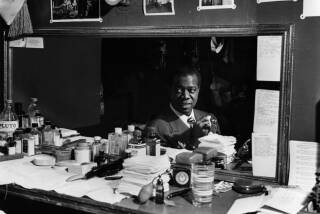REISSUES : Basie, Lunceford Releases a Study in Contrasting Styles : ***** COUNT BASIE; “The Complete Decca Recordings” <i> Decca</i> : *** THE JIMMIE LUNCEFORD ORCHESTRA; “Stomp It Off” <i> Decca</i>
- Share via
With all due respect to Benny Goodman (and respect certainly is due him), if any one artist deserved the title “King of Swing,” it was Count Basie. His orchestra in its formative years was a marvel of pulsating cohesion, in which the lack of complexity enabled the musicians to listen to one another sensitively in the quest for a subtly unified beat.
This three-CD, 63-track set encapsulates his band’s first three definitive years, one disc each for 1937, 1938 and 1939.
Such was the looseness and seeming informality of this 13-man ensemble that it has often been wrongly assumed to have relied on “head” arrangements that were made up spontaneously on the bandstand. Actually, all but four of the 46 instrumental band numbers in this collection (there are 10 tracks played by the rhythm section only) used charts by such noted arrangers as Eddie Durham, Don Redman and Jimmy Mundy.
Every soloist has his distinct style. Lester Young’s tenor sax with its dry, laconic sound marked a revolutionary contrast to the fuller, warmer tone of Coleman Hawkins that had long been the norm. Trumpeter Harry (Sweets) Edison, using humor-tinged bent notes and buoyant phrases, was immediately recognizable.
The rhythm section, with its rare sense of unity and reluctance to rely on excessive volume, was a sort of forerunner of the Modern Jazz Quartet in its rhythmic refinement. Basie’s partners in that team were Freddie Green on guitar, Jo Jones on drums and Walter Page on bass.
Basie’s aura of informality was unique among swing bands of the day. The chief reasons for this were his generous allocation of solo space to such giants as Young and Edison, as well as trumpeter Buck Clayton and trombonist Benny Morton. Invaluable too was the almost improvisational sense with which the sax and brass sections phrased every measure.
The blues, in various forms and at every tempo, was a recurrent theme and is central to the 10 tunes played by just Basie and the rhythm section. “One O’Clock Jump,” the Basie theme that is played by the complete orchestra, may be the most durable instrumental blues of all time.
Surprisingly, many of Jimmy Rushing’s commanding vocals were not blues-based; too often he had to sing such trivia as “Boo Hoo” and “Stop Beatin’ ‘Round the Mulberry Bush.” Helen Humes has five vocals, mostly pop songs, but her blithe performances sublimate these.
There are six rare extra takes, two by the band and four by the rhythm group. All the evidence here reminds us that in the early years Basie was a two-fisted stride pianist with far more technique than he would display in his eventual “Plink-Plank-Plunk” simplicisms.
There was no sharper contrast between bands of the 1930s than the qualities that separated the Basie orchestra from that of Jimmie Lunceford. Unlike Basie, who was an easygoing leader and gave his men all the leeway they desired, Lunceford was a martinet who insisted on strict discipline.
Additionally, he conducted the band (which Basie rarely did), almost never played an instrument in public, used vocal group novelties and relied heavily on arrangements--often brilliant ones concocted by Sy Oliver, a member of his trumpet section, and Ed Wilcox, his pianist--rather than star soloists. This dependence on arrangements resulted sometimes in a slight stiffness; there was an occasional tendency to rely on notes played staccato, lacking the easy relaxation of a Basie performance.
This single CD covers a limited period (1934-35) before the orchestra hit its stride; many of the band’s true masterworks were made several years later for Columbia Records and inexplicably have not been issued on CD. Still, the band at its best was sui generis, even in this early stage of its evolution. It managed for the most part to combine jazz validity, danceability and entertainment value in a manner achieved by no other swing band.
Oddly, six of the compositions were written by Duke Ellington, whose band surpassed both Lunceford’s and Basie’s in overall creativity. But these are not Ellington’s arrangements, and for the most part they emerge as neither typical Duke nor typical Lunceford.
New albums are rated on a scale of one star (poor) to four (excellent). A rating of five stars is reserved for classic reissues or retrospectives.
More to Read
The biggest entertainment stories
Get our big stories about Hollywood, film, television, music, arts, culture and more right in your inbox as soon as they publish.
You may occasionally receive promotional content from the Los Angeles Times.










